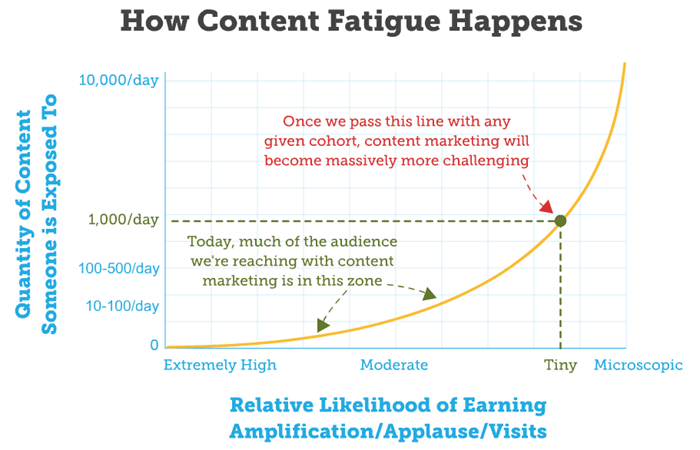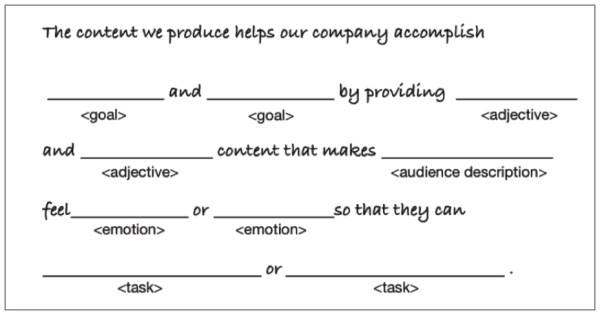Content marketing has taken the marketing industry by storm over the past few years, and as a result, we’ve seen an astronomical increase in the amount of content produced and posted online. Everyone was quick to jump on the content marketing bandwagon, lured in by the promise of an engaged audience and the opportunity to stand out above their competitors. However, with all the excitement, oftentimes you find the core purpose of content marketing lost, and strategy buried in the shuffle.
At Zion & Zion, we’re always keeping an eye on the latest trends and turning tides throughout the marketing industry. More and more, it’s becoming clear that content marketing is increasingly linked to content fatigue, a phenomenon that every marketer should be aware of.
What is content fatigue?
Before you can work to avoid content fatigue, it’s helpful to understand what it is.
The amount of information online continues to increase. Meanwhile, the amount of time we have to consume this information isn’t getting any longer—in fact, it’s shrinking, as users spend more time divided between various apps. At the center this comes content fatigue; there’s too much to read, too much to consume, and not enough time to do it. For content creators, this means your audience could very well be burnt out before they even get a chance to read your content. Of course, this doesn’t just apply to blogs—content also includes images, social posts, podcasts, and more.

As the above graph displays, the majority of a content marketer’s audience is still within the zone indicated with the green dotted line, wherein consumers are exposed to up to 1,000 pieces of content a day and still have a high chance of interacting with it. However, as the quantity of content increases, the relative chance that the audience will interact with the content decreases rapidly.
Since content marketing shows no signs of slowing down, it’s almost inevitable that we’ll reach the point of no return, where it won’t be enough to just publish your content and expect your audience to respond.
So, what can I do about content fatigue?
The idea of content fatigue can sound bleak. But, fear not. Not all hope is lost for content creators. There are several key steps you can take to make sure your valuable content doesn’t get lost in the shuffle or disregarded by weary content consumers. At Zion & Zion, we implement all of the following steps to guarantee our content makes an impact.
Find your niche
Finding a niche for your content is a great way to separate it from the crowd. Of course, that may seem easier said than done, especially if you’re writing for a large industry. However, no matter what industry you’re in, there’s sure to be something unique that you, or the brand you’re creating content for, bring to the table.
Are you an expert in your field? Do you have a perspective no one shares? Think about how your life experiences can help shape your role as a content creator. If you’re writing on behalf of a brand, think about how that brand’s unique selling proposition can manifest itself though the content you create. Keeping a unique, yet valuable, angle in mind when creating content can carve out your niche and give your audience a reason to keep coming back.
Keep a goal in mind
Your content should be created for a purpose. Whether it’s to improve SEO, increase conversions, or other metrics, creating content around a specific purpose helps cut down on the flow of purposeless content that floods the web. At each step of your content creation process, from brainstorming to publishing, you should keep your desired outcome in mind.
Some common content marketing goals include:
- Building brand awareness
- Increasing site engagement
- Increasing organic traffic
- Promoting a new product or service
If you’re stuck on trying to figure out the “why” behind content marketing for your business, one easy way is to create a core content strategy statement. The Content Marketing Institute created a template that can be used to narrow down exactly what you’re looking to accomplish.

Improve SEO
SEO and content marketing have a complicated relationship. Great content marketing cannot exist without great SEO. Even the best written blogs will have no impact if SEO isn’t accounted for.
At Zion & Zion, we ensure our content is optimized for SEO by using guidelines like the following:
- 1,000+ word count
- Including keywords in headings
- Utilizing internal and external links
Following these guidelines can help your content rank better in Google searches than it would on its own. And remember, higher rankings mean more clicks, and more eyes on your content. To learn more about the relationship between content and SEO, check out our blog post on how SEO evolved into content marketing.
Promote your work
Once you’ve published your article, blog post, or other content piece, the job isn’t over. Imagine if Hollywood released a movie to theatres without any fanfare—no trailers, no teasers, no promotions. How would anyone know to go see it? The same is true for your content. Let your audience know that there’s a shiny new piece of content ready for them by using whatever tools and platforms you have. For example, an email blast or a promoted Facebook post can be useful for getting the word out.
Bring more to the table
Just relying on words may not be enough to make your content stand out any more than your competitors. If you’re not already, you should be using visuals, audio, and video in your content mix. That means infographics, podcasts, video tutorials, photos, interactive content, or anything capable of providing your audience with a variety of ways to access your information will keep them coming back for more. In fact, creating unique content is one of our top three things every content creator should focus on.
Keep up the pace
Consistency counts in the world of content marketing. Producing valuable content on a regular basis gives your audience a consistent schedule of content to look forward to, and reduces the amount of time that your content will not be up to date. Try to establish a schedule for 6-12 months at a time through the use of a content calendar filled with potential topics.
If topics seem hard to come by, look to what others are publishing in your industry and re-work the topics to suit your brand. Consider the sorts of things that you as a reader would want to click on if you saw them in a Google search. A useful tool for this is Google Trends. For every search term, it allows you to see trending related terms, and allows you to explore what your audience is searching for by narrowing down demographics.
Next steps
Hopefully, these tips have you feeling confident and ready to create memorable content for your audience. Despite the threat of content fatigue, content marketing isn’t going anywhere anytime soon. It’s up to us as content creators to evolve our approach so we can deliver useful and memorable content to our audiences.
